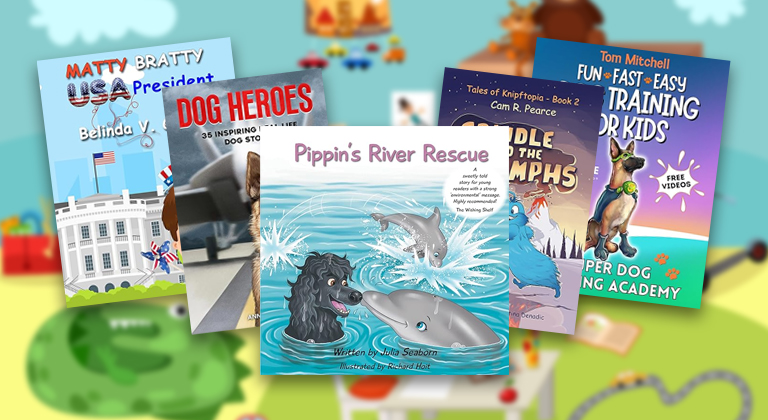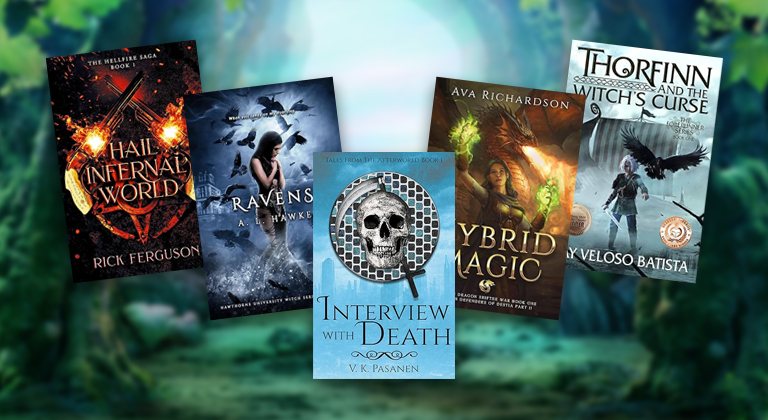Writing in the Third-Person Perspective: A Guide
Over the last couple of weeks, we’ve published a couple of articles on first-person perspective in writing – which can be a fun and productive exercise even if you ultimately choose not to pursue that style of writing in your work. But there is more than one way to tell a story, and many authors prefer writing in the third-person perspective. So today, Ginger is giving the details on writing in that style, and some of the common issues to keep in mind while doing so.
When I wrote my blog post Defending First-Person POV, I didn’t anticipate the number of people who disagreed with me – and while I might not share their opinion, they all made valid points – and I think it’s a point worth discussing.
For a start – don’t listen to me! If you want to write your story in third-person, go right ahead. I just think the first-person perspective is a powerful one; but only if it fits what you’re trying to say.
But just as the first-person perspective empowers a reader to enter the heart and soul of a character, the third-person perspective is a powerful “God’s eye view” of a story, and isn’t just a robustly serviceable style of narrative, but one that offers a flexibility to your storytelling that the first-person perspective can’t equal.
I claim the third!
One of the reasons the third-person perspective style of writing is so popular among authors is because it’s popular among authors – it’s the default style of writing, and anybody who interested in writing and publishing has probably had their narrative shaped by books written in this practically ubiquitous style.
I speak from experience. While I might write in the first-person perspective now, it was James Bond, and The Saint, and Jilly Cooper’s romances that shaped the stories I like to tell, and they were all written in third-person perspective.
As I got older, the fantasy books I used to love were similarly written from this perspective – and, arguably, the most influential movies of all time similarly reinforced this because you got to see things that the hero or heroine wouldn’t – such as how Luke Skywalker had no idea that Darth Vader was up on the Death Star choking out his minions in the first few minutes of his story, but we – the audience – got to see that delightful scene ourselves (“Your lack of faith is disturbing.”)
A lot of thrillers, murder mysteries, and other genres employ this because it offers a great way to add exposition to a story which would be difficult in first-person perspective, and it allows a lot of flexibility in ‘flow’. An example of that would be following one character into a room, recording an interaction, and then following the second character out of the room.
I’ve always called it a ‘God’s eye view’ because you can literally dip in and jump out of any character’s scene, at any time, anywhere in your story. Its like playing that video game The Sims, where you have an overhead view of all the characters, and can zoom in on whichever one is doing something interesting at the time.
However, while this approach offers a lot of flexibility – it also presents challenges. One of the reasons I like writing genre romance, and writing in first-person, and even penning poetry is because it has a format. Rules. You know what you can and can’t do with it, and to quote T.S. Eliot: “When forced to work within a strict framework the imagination is taxed to its utmost – and will produce its richest ideas. Given total freedom the work is likely to sprawl.”
For years, I worked in the advertising industry, and one of my mentors showed me how the more defined a client’s request is, the easier it is to fulfill. He quoted the great David Ogilvy, who said: “Give me the freedom of a tight brief.”
But for a lot of writers, the appeal is the freedom – and that’s why they enjoy third-person perspective so much. There’s nothing wrong with that – in fact, freedom of expression should be celebrated – but from a reader’s perspective, here are some things to keep in mind:
The Story Comes First
If there’s been a reoccurring thread to my blogs in recent weeks, it’s that you need to ruthlessly divorce story from writing. The story is the sheet music, and the writing is the instrument you play it on. Great works of literature could be considered a philharmonic orchestra, while genre books could be considered ‘pop music’ because they have mass appeal, but ultimately you should be able to take the writing style of one and marry it to the story of the other and still have something worth reading.
So, just as I recommended with the first-person perspective, make sure you have your story buttoned up first. Stories should have a structure – I enjoy using the story circle to figure it out – and the events of the story shouldn’t change whether you write it in the third-person or first-person (in fact, I even warned that if your story DID shift in your mind when you swapped writing perspective, you should go back and reexamine it because your character’s motivation is probably a little off.)
The advantage of doing this is that you then have a ‘map’ of the story, and a map of what all the characters are doing throughout the story. Then you can dip in and write specific scenes about specific characters with a freedom you don’t have in first-person perspective.
I’d even go so far as to draw out a timeline of your story and actually highlight the journey of each of the characters – maybe drawing a line with a different colored pen. That way, you can see what order things happen in, and decide which characters you should focus on at different points in the story.
If you’re a pantster rather than a plotter, this suggestion might be a bit off-putting to you. If that’s the case – ignore it. Pantsters normally have a talent for sewing a parachute after they’ve thrown themselves into the first chapter, and with any luck they’ll have finished it by the time they reach the words THE END. However, as a reformed pantster, I’ll tell you that plotting a story is a REALLY powerful step and you should start experimenting with it more often.
Watch for Transitions
As an editor, the most frequent problem I came across in other people’s books was when they shifted focusing on one character in a scene, and moved onto another character without so much as blinking.
I won’t take a real example, but this is a fairly close one from a book I edited recently:
Marcus walked into the room, and found Neil waiting for him.
He put his hands on his hips and snorted:
“What are you doing here, Neil?”
He narrowed his eyes, balling his hands into fists.
“Leaving, actually.”
With a snarl, he turned and strode out of the room. He couldn’t believe the cheek of that guy! Fortunately, Denise had her office just down the hall, so he strode down there to vent to her about his colleague.
Chances are, that might have read fine to you – but you might also have got hung up on the ‘he’ bit. When we started that scene we were following Marcus, and he put his hands on his hips. The next ‘he’ refers to Neil, though – and that’s who balls his hands in response, and then strides out of the room.
Without specifically calling them out by name, it’s difficult to know which ‘he’ is who, until you finish the sentence and gather context. If you think this is a valid complaint, just imagine an entire chapter written like this – with shifting perspectives from multiple characters, many of whom are referred to as simply ‘he’ for the majority of their bit.
There are various ways to address this. I like the method in which chapters are written using third-person perspective, but you only follow one character through that scene. If the perspective shifts, you shift chapters. This makes it clear who is being written about, but you can still pop in and out of different character journeys in a way you can’t if you’re writing your book from the first-person perspective of just one or two characters.
Another option is simply tighter editing – be sure to use names where you can, to clarify whether or not ‘he’ refers to Neil or Marcus. If that gets a bit repetitive (trust me, it will) you should come up with a consistent two-word descriptor for that character which is interchangeable (for example, ‘the steely eyed inspector.’) That way, you can make it clear.
Finally, you could have a section break – or just describe the shift better. For example, you could add a single line to the paragraph above which helps the reader ‘shift’ from Marcus to Neil:
Marcus walked into the room, and found Neil waiting for him.
He put his hands on his hips and snorted:
“What are you doing here, Neil?”
Neil had been waiting for him for fifteen minutes, just to make a dramatic exit. He narrowed his eyes, balling his hands into fists.
“Leaving, actually.”
That single line stops the reader in their tracks and forces them to think: “Oh, I see, we’re seeing things from Neil’s perspective now” and subsequently, the next few ‘he’ sentences are clearly referring to Neil.
It’s a straightforward approach, but very important. As I’ve said before, the essence of good writing and editing isn’t perfectionism, but flow. You want to make sure your writing is clear, and a reader can be immersed in it without anything throwing them back out into reality when they don’t ‘get it.’ That can be a typo, a misused word, or a scene in which it’s confusing which character is doing what.
Cut the Fluff
Using third-person perspective, you can dip in and out of any scene, at any point in the story, and present it to the reader – but before you do, you should ask WHY.
While there’s nothing wrong with longer books – heck, Stephen King has made a career of them – there has to be some meat to what you write. Chopping and changing and switching character perspectives is fine – as long as the scenes you include actually add to the story, either in terms of moving the plot forward, or providing characterization.
This is another reason why the first-person perspective is popular with romance genre authors – because their books are generally designed to be on the shorter side, and by writing from only the hero and heroine’s alternating perspectives, you only have to write about the events they witness, experience, or learn about. This means you can’t put in scenes that don’t fit those perspectives – for example, writers would have had to nix the scene of Darth Vader choking his subordinate if Star Wars was a romance novel (although given the onscreen kiss in Star Wars is between Luke and Leia, maybe it’s a good job Star Wars isn’t a romance novel.)
While you have more flexibility to follow other characters in a third-person perspective story, you have to be disciplined about whether you should. Switching perspectives can interrupt the pace of a book as it is, and if you indulge yourself by writing a scene that doesn’t really drive the story or enrich the characters – even if it’s really, really good – it might be a better idea to shelve it to preserve the pace and brevity of your novel.
Of course, if you’re anything like me, you can feel incredibly protective of some scenes you’ve written – and nixing them would be like cutting off a metaphorical finger. However, unless you can definitively define how the scene progresses the book, it doesn’t.
Again, this is where plotting comes in so handy. If you plan out your story as I described above, outlining the experiences of each character and how they intertwine, it’s easier to choose which scenes to include, which events to mention in passing, and what to leave unwritten. Look for scenes in which character threads overlap, or in which one character’s actions impact the lives of other characters. These are the clues that the scene is important to include. If in doubt, ask yourself: What about the plot won’t the reader understand if I do leave out the scene?
If the scene isn’t a supporting pillar for the story, or a rich tapestry of characterization, it’s just words on a page; and I usually remove them and store them in a separate document which I can then offer as bonus content to fans, or to cannibalize for cute turns of phrase or good description. Words don’t need to be wasted – either by including them unnecessarily in your manuscript, or by not saving them to repurpose them.
Conclusion
The third-party perspective is a very popular choice of writing and reading style, and not without good reason. While a lot of authors swear by it – especially over first-person perspective writing – it does come with some challenges to be aware of. Hopefully this blog covered some of the most important ones, and will help you hone your craft as you write in this point of view.












Your second example with Marcus and Neil is still an error. You shouldn’t switch perspectives within the same scene. There should be no mention of the 15-minute wait. Marcus can’t know that, and his is the current POV. If there’s a break in the chapter, or if a new chapter has begun, then you can switch POVs to anyone. But you need to stay there.
A more subtle (and common) error would be if Marcus described Neil as “very angry.” Technically, that’s a POV switch, too. It should read, “plainly very angry.” Again, Marcus can’t know what’s in Neil’s mind, but can determine it from his face, actions, etc. So words like “clearly” and “obviously” are often necessary to reinforce the main POV when thinking about how another character feels.